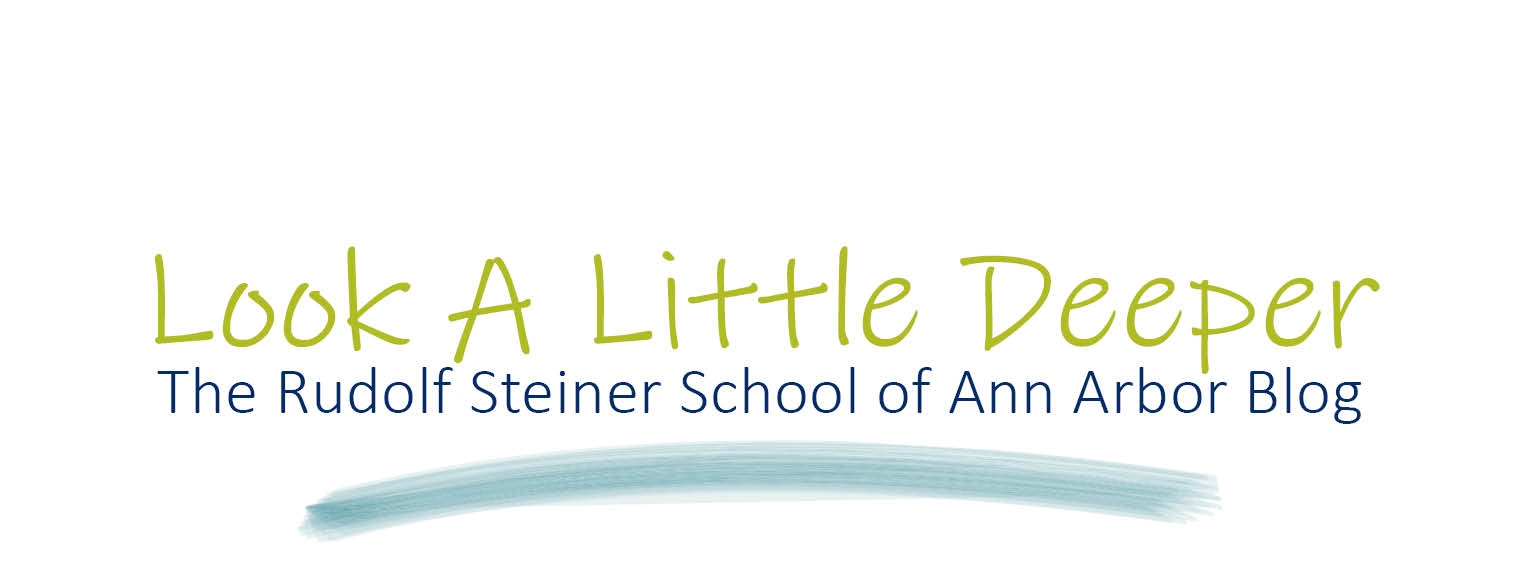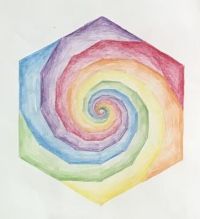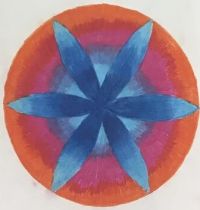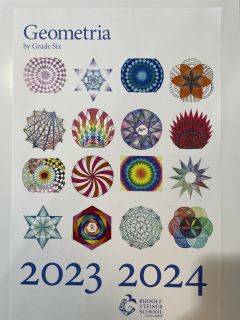

Geometry in a Waldorf School
Waldorf schools in many regions of the world teach two rather unusual classes: form drawing and eurythmy. These two art forms are generally unique to the Waldorf curriculum.
Eurythmy is a moving form made when a person or people express the beauty of the sounds of human speech, musical tones, scales and intervals with specific, whole-body gestures. The students in Waldorf schools are generally introduced to these movements in either bi-weekly classes for several weeks in a row or even weekly classes all school-year long.
 Form drawing is a much smaller movement of the hand on paper, but some of the forms that are moved in eurythmy are also forms students can recreate on paper. Form drawing is used to hone fine motor skills, practice midline crossing, create beauty, develop spatial awareness, practice balance in movement and form on a page, encourage movement in four directions across a page: forwards, backwards, up and down and to promote harmony. Form drawing in the early grades is frequently its own special class, but it can also be woven into the content of the students' main lessons. The form drawing experiences that students are introduced to in grades 1-4 create a familiarity of experience so that when the development of form in precision that is called geometry is brought in grades 5–8, their past experience makes it easier to create their first geometric constructions.
Form drawing is a much smaller movement of the hand on paper, but some of the forms that are moved in eurythmy are also forms students can recreate on paper. Form drawing is used to hone fine motor skills, practice midline crossing, create beauty, develop spatial awareness, practice balance in movement and form on a page, encourage movement in four directions across a page: forwards, backwards, up and down and to promote harmony. Form drawing in the early grades is frequently its own special class, but it can also be woven into the content of the students' main lessons. The form drawing experiences that students are introduced to in grades 1-4 create a familiarity of experience so that when the development of form in precision that is called geometry is brought in grades 5–8, their past experience makes it easier to create their first geometric constructions.
In grade 5 the students generally experience something called free hand geometry. Free hand geometry begins with the ability to draw and identify different shapes. To see shapes as they emerge from curved and straight lines working together in pattern. How close can they come to a perfect freely drawn circle? They may practice moving in a circle with their bodies, or as a group. Students may imagine a form that develops from walking around in a circle holding a long dowel and then try and draw their movement experience. As much as possible, any abstract concept or idea is brought as an experience first. This works with sciences and math in Waldorf schools. In conventional education, simple plane geometry is brought for students to study in middle school and this is also true for Waldorf schools. The difference is that in order to keep the experience of shapes alive, the students create forms before they begin to experience the measurement and definitions of angles, area, volume and dimension.
In sixth grade the students may begin their year with a review of the free hand geometry they experienced in grade 5 to bring their attention back to different forms they experienced. They can also study some of the ancient peoples who used geometric forms in practical application. The usefulness of the right triangle to create straight lines and right angles, the beauty of the perfect circle and all its myriad of uses.
 The students can be encouraged to think about some of the most powerful shapes in human existence. A recognition of the cycles created by the sun, moon and Earth working together leads to a discussion of the shapes of the sun, moon and Earth, lending itself beautifully to an in-depth exploration of the power of the circle, the ellipse and the oval. From this introduction, the children can try making a perfect circle in many ways. Then they can be introduced to their first geometry tool, the compass, beautifully and sturdily made of high-quality aluminum or steel. Once the compass begins to be used, the drawings become detailed, elaborate, beautiful and supremely precise. The right triangle provides a straight edge to find points on a circle to divide it in half. The semi-circle is formed. Then two lines can be drawn through a circle and the students recognize a cross. The places where the circle is crossed by the lines create four points on the circle which, when connected along the circumference, create a diamond and, when turned on its side, a square. The students continue to inscribe different shapes inside the circle finding that interweaving circles will create points that are equidistant from one another and now perfect rectangles, squares, triangles, stars, and over lapping circles can be drawn.
The students can be encouraged to think about some of the most powerful shapes in human existence. A recognition of the cycles created by the sun, moon and Earth working together leads to a discussion of the shapes of the sun, moon and Earth, lending itself beautifully to an in-depth exploration of the power of the circle, the ellipse and the oval. From this introduction, the children can try making a perfect circle in many ways. Then they can be introduced to their first geometry tool, the compass, beautifully and sturdily made of high-quality aluminum or steel. Once the compass begins to be used, the drawings become detailed, elaborate, beautiful and supremely precise. The right triangle provides a straight edge to find points on a circle to divide it in half. The semi-circle is formed. Then two lines can be drawn through a circle and the students recognize a cross. The places where the circle is crossed by the lines create four points on the circle which, when connected along the circumference, create a diamond and, when turned on its side, a square. The students continue to inscribe different shapes inside the circle finding that interweaving circles will create points that are equidistant from one another and now perfect rectangles, squares, triangles, stars, and over lapping circles can be drawn.
 This exploration could probably go on for months, but it is extremely important not to wear a subject out and so, eventually, the first formal geometry lesson must come to an end. Students frequently have been introduced to the parts and nomenclature for a circle, different triangles, protractors and the measurement of degrees in some shapes, especially the circle. They may be introduced to Euclid and his ideas and even a few of his proofs in very generic terms, and they may practice using the protractor to measure angles. Some classes will go so far as to describe the difference between a line and a point, or the introduction of a line segment, plane, and a polygon. Most students understand the difference between parallel and perpendicular lines by the end of grade 6. Some classes will get as far as an introduction to the perimeter and area of right triangles, circles, and squares/rectangles.
This exploration could probably go on for months, but it is extremely important not to wear a subject out and so, eventually, the first formal geometry lesson must come to an end. Students frequently have been introduced to the parts and nomenclature for a circle, different triangles, protractors and the measurement of degrees in some shapes, especially the circle. They may be introduced to Euclid and his ideas and even a few of his proofs in very generic terms, and they may practice using the protractor to measure angles. Some classes will go so far as to describe the difference between a line and a point, or the introduction of a line segment, plane, and a polygon. Most students understand the difference between parallel and perpendicular lines by the end of grade 6. Some classes will get as far as an introduction to the perimeter and area of right triangles, circles, and squares/rectangles.
The beauty of this style of education is that the teacher can mold the curriculum to fit the students in their classroom, not the other way around. The shapes, patterns and color possibilities for these first geometric drawings in grade 6 lend themselves wonderfully to being put on display. In 2023 each sixth grader at RSSAA was encouraged to chose one geometric image to be reproduced on a printed calendar. Enough of the students were motivated to participate that a 24-month calendar was created instead of a 12-month calendar. The care and attention that most of the students took with their images was such a wonder to behold that having a place to showcase their work motivated even more careful attention than if their images had just been for their own main lesson books!
